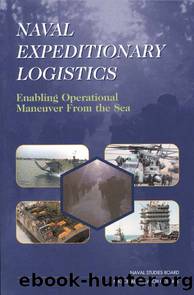Naval Expeditionary Logistics: Enabling Operational Maneuver From the Sea by National Research Council

Author:National Research Council
Language: eng
Format: epub
Tags: Conflict and Security Issues : Military and Defense Studies
Publisher: NATIONAL ACADEMY PRESS
Published: 1999-02-10T00:00:00+00:00
Figure 4.1 depicts a typical logistics structure for supporting todayâs Marine Corps operations. Combat units have, in their own combat trains, a capability to meet immediate needs for fuel, ammunition, and other supplies. That capability for most units is modest, consisting of several cargo trucks and trailers and a 1,200-gallon fuel tanker that are usually in a battalionâs headquarters and services company. For some units, however, the capability is substantial: for example, in an artillery battalion it includes forklifts and trucks for hauling ammunition; in a tank battalion it includes mobile assault bridging and several fuel tankers.
The combat service support detachment (CSSD) is an ad hoc, mission-tailored organization created from the supply, maintenance, engineering, transport, and medical battalions of a force service support group. It provides the forward logistics support to deployed units. The flexibility inherent in the CSSD concept allows many variations in organizational makeup and employment: large or small, ground- or air-deployed, mobile or stationary.
A forward arming and refueling point, another ad hoc activity, provides limited replenishment of operating supplies, usually for helicopters, well forward in the area of operations. It permits the helicopters to operate for extended periods without returning to a base.
The force service support group (FSSG) is the major logistics organization in a Marine expeditionary force. In addition to being the parent of the elements composing the combat service support detachments, the FSSG is the base for most in-theater logistics activity. When the distances from ports to combat units are long (e.g., over 50 miles), a Marine Logistics Command (MLC) may be added, as depicted in Figure 4.1. An MLC conducts port activities, receives and stores incoming materiel, and provides long-haul land transport to the FSSG.
As with most aspects of its operations, the Marines Corps is adept at tailoring logistics support to the mission at hand, and the basic techniques employed provide a great deal of flexibility. OMFTS, however, suggests that even if the basic techniques may endure, significant changes in emphasis and organization may be needed to support future operations. Figure 4.2 depicts the principal nodes, as seen by the committee, in the OMFTS logistics system. The major differences are a reduction of the logistics presence, or "footprint," ashore; the potential for very long distances between the combat units and their base of logistics support; and the introduction of a sea base. The implications of these differences are difficult to separate, for all aspects of a logistics system are interrelated. Nonetheless, for convenience in discussion, they are addressed in the following three sections.
FIGURE 4.2
Principal nodes in OMFTS logistics system.
Download
This site does not store any files on its server. We only index and link to content provided by other sites. Please contact the content providers to delete copyright contents if any and email us, we'll remove relevant links or contents immediately.
The Radium Girls by Kate Moore(10959)
The Templars by Dan Jones(4218)
100 Deadly Skills by Clint Emerson(4123)
Rise and Kill First by Ronen Bergman(4059)
The Doomsday Machine by Daniel Ellsberg(3768)
The Rape of Nanking by Iris Chang(3564)
Killing England by Bill O'Reilly(3486)
Hitler in Los Angeles by Steven J. Ross(3470)
Stalin by Stephen Kotkin(3116)
12 Strong by Doug Stanton(3077)
Hitler's Monsters by Eric Kurlander(2760)
Darkest Hour by Anthony McCarten(2671)
Blood and Sand by Alex Von Tunzelmann(2630)
The Art of War Visualized by Jessica Hagy(2442)
Hitler's Flying Saucers: A Guide to German Flying Discs of the Second World War by Stevens Henry(2320)
The Code Book by Simon Singh(2246)
The Second World Wars by Victor Davis Hanson(2149)
Babylon's Ark by Lawrence Anthony(2092)
Tobruk by Peter Fitzsimons(2079)
